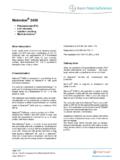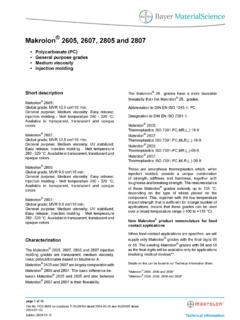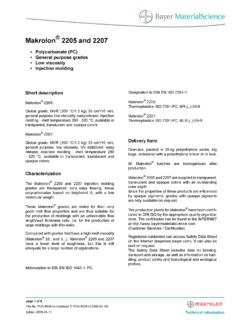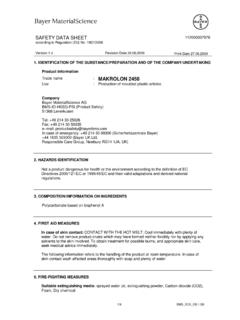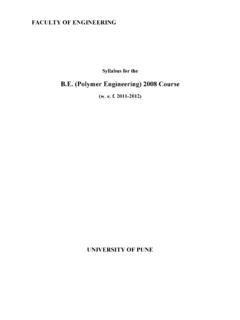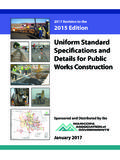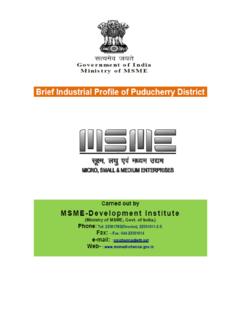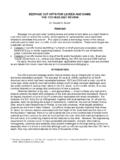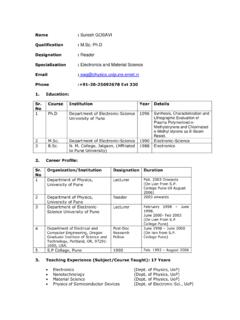Transcription of Makrolon 2405 and 2407 - lidorr.com
1 Page 1 of 11 File No. PCS-8064 en (replaces TI KU28025 dated 2004-06-16)Edition 2008 -03-19 Technical InformationMakrolon 2405 and 2407 Polycarbonate (PC) General purpose grades Low viscosity Injection moldingShort descriptionMakrolon 2405:Global grade; MVR 19 cm /10 min; General purpose;Low viscosity; Easy release; Injection molding-Melttemperature 280-320 C; Available in transparent,translucent and opaque colorsMakrolon 2407:Global grade; MVR 19 cm /10 min; General purpose;Low viscosity; UV stabilized; Easy release; Injectionmolding-Melt temperature 280-320 C; Available intransparent, translucent and opaque colorsCharacterizationThe Makrolon 2405 and 2407 injection moldinggrades are transparent, easy flowing, linear polycar-bonates based on bisphenol Makrolon grades are noted for their very goodmelt flow properties and are thus suitable for the pro-duction of moldings with an unfavorable flow length/wall thickness ratio, for the production of largemoldings with thin with grades that have a high melt viscosity( Makrolon and ), Makrolon 2405 and 2407have a lower level of toughness, but this is still per-fectly adequate for a large number of to DIN EN ISO 1043-1: PCDesignation to DIN EN ISO 7391-1: Makrolon 2405:Thermoplastics ISO 7391-PC,MR,(,,)-18-9 Makrolon 2407.
2 Thermoplastics ISO 7391-PC,MLR,(,,)-18-9 These are amorphous thermoplastics which, wheninjection molded, provide a unique combination ofstrength, stiffness and hardness, together with tough-ness and breaking strength. The heat resistance ofthese Makrolon grades extends up to 135 C, de-pending on the type of stress placed on thecomponent. This, together with the low-temperatureimpact strength that is sufficient for a large number ofapplications, means that these grades can be usedover a broad temperature range (-100 to +135 C).New Makrolon product nomenclature forfood contact applicationsWhen food contact applications are specified, wesupply only Makrolon grades with the final digits 06or 56. The existing Makrolon grades with 08 and 58as the final digits are available only for applicationsinvolving medical on this can be found in our Technical Information Sheets.
3 " Makrolon 2456"" Makrolon 2458"Delivery formGranules packed in 25-kg polyethylene sacks, FIBC(flexible intermediate bulk containers big bags),large cartons with a polyethylene inliner or in Makrolon batches are homogenized injection molding grades Makrolon 2405 and2407 are supplied in transparent, translucent oropaque colors with excellent depth of production plants for Makrolon have been certifi-cated to DIN ISO by the appropriate quality organiza-page 2 of 11 File No. PCS-8064 en (replaces TI KU28025 dated 2004-06-16)Edition 2008 -03-19 Technical Informationtions. The certificates can be found in the INTERNETat (Customer Services / Certificates).Registered customers can access Safety Data Sheeton the Internet ( ). It can also besent on Safety Data Sheet includes data on labeling,transport and storage, as well as information on han-dling, product safety and toxicological and engineering:Interior componentsElectrical/Electronics:Switch covers, switch housings, electronic housingsHousehold articles/consumer goods:Housings for electrical appliancesLighting engineering:Light diffusers, strip light reflectors, louvers,light conducting elements, starter bushingsSafety equipment:Welders gogglesProperties (see also table)The key characteristic features of molded parts inMakrolon 2405 and 2407 are.
4 -outstanding light transmission(transparent grades)-high strength and impact strength-dimensional stability, very low dimensionalchanges-high heat resistance-excellent electrical and dielectric propertiesMechanical propertiesMolded parts made of Makrolon 2405 and 2407rank among the rigid materials on account of theirstrength and hardness, yet also amongst the elasticmaterials on account of their toughness. The lowlevel of correlation between mechanical propertiesand temperature is striking; up to 140 C, stress-freeparts remain hard and parts are to be produced that will be exposed todynamic loading, we recommend that model tests beconducted in excess of 20 MPa at 20 C and in excessof 10 MPa at 60 C can lead to surface cracking aftera period of more than 104 hours. If the parts are em-ployed in media other than air, then the permissiblevalues may differ.
5 Over and above this, allowancemust be made for reduction factors as a function of thedifferent influencing parameters ( the molded partgeometry, gate design and processing conditions).These reduction factors must be specified for eachindividual of coloring on thoughnessThe majority of transparent colors do not cause anychange in properties, or at least no major pigments affect toughness depending on thetype and quantity of pigment tough elastic properties of the low molecularMakrolon grades are influenced to a greater ex-tent by the coloring than those of the higher molecularMakrolon and particular requirements are placed on tough-ness, preference should be given to higher propertiesComponents made from the Makrolon series ofgrades are noted for their high heat resistance. At lowloading levels ( inherent weight) the parts do notundergo any essential deformation at up to 135 above 145 C (glass transition temperature), Makrolon starts to soften and as from approximately220 C it assumes the molten state.
6 Even higher tem-peratures are required, however, before it attains aflowability that will permit it to be processed on injec-page 3 of 11 File No. PCS-8064 en (replaces TI KU28025 dated 2004-06-16)Edition 2008 -03-19 Technical Informationtion molding and extrusion machines. Lengthy periodsof heating to temperatures in excess of 320 to 340 Clead to thermal decomposition, with carbon dioxidebeing split off, and coefficient of thermal expansion is lower than formany other thermoplastics. If the material is subjectto temperatures in excess of about 80 C for longperiods of time, then a structural change will occuras a function of the temperature and duration ofthe thermal treatment which is characterized by aslight increase in the tensile and flexural strengthand a reduction in the notched impact maximum permitted service temperature forparts made of Makrolon grades depends onthe shape of the molded part, the type of loadingand the specifications.
7 The temperature indices toIEC 60216-1 and UL 746 B can be regarded aspractical reference values for the permitted maximumtemperatures during long-term a component is subject to a high temperatureand simultaneous mechanical loading, the creepbehavior must be taken into account. Further detailson this can be found in the CAMPUS propertiesThe favorable electric properties of molded parts inMakrolon grades are not influenced notably bytemperature fluctuations or by ambient humidity. Thechange in the measured values at higher frequenciesmust be taken into account when Makrolon is usedin the high-frequency sector. A further advantage isthat no electrolytic corrosion is propertiesMakrolon parts made from grades in the have a high refractive index of Thevirtually colorless, transparent grades possess a lighttransmission of up to 89 % in the visible light, by contrast, is absorbed and leadsto yellowing and a reduction in the impact strength inthe course of time.
8 In all cases where UV radiationis emitted, and particularly when it is emitted inconjunction with high temperatures, a UV-stabilizedgrade should be used ( Makrolon 2407). Finishedparts, and particularly lamp diffusers, can be givensubsequent UV protective treatment if towards moisture and water(hydrolysis resistance)Molded parts in Makrolon absorb only % water at room temperature with 50 % relativehumidity. The physical/technological properties re-main virtually unaffected. The dimensional changesare similarly insignificant. With immersion in waterand rising temperatures, values of only % or soare achieved. The steam permeability, measured on100 m thick film, is 15 g/m d. A notable level of per-meability also exists for other gases (hydrogen, car-bon dioxide, sulfur dioxide, helium and ethyleneoxide).
9 For applications requiring hydrolysis resistanceMakrolon 2456 should be resistanceMakrolon is resistant to mineral acids, including inhigh concentrations, to a large number of organicacids ( carbonic acid, lactic acid, oleic acid andcitric acid), to oxidation and reducing agents, neutraland acidic saline solutions, a range of greases andoils, saturated aliphatic and cycloaliphatic hydrocar-bons, and also alcohols, with the exception of methylalcohol. Makrolon is destroyed by alkaline solutions,ammonia gas and its solution, and amines. Makrolon dissolves in a number of industrial solvents. Otherorganic compounds, such as benzene, acetone andcarbon tetrachloride, cause it to is generally adequate for a large num-ber of applications and particularly for indoor applica-tions. For stringent requirements, use of the UV stabi-lized grade, Makrolon 2407, is recommended.
10 Maxi-mum resistance can be attained in finished partsthrough the subsequent application of a UV 4 of 11 File No. PCS-8064 en (replaces TI KU28025 dated 2004-06-16)Edition 2008 -03-19 Technical InformationProcessingPre-treatment / drying1) Makrolon must be dried prior to processing. Forinjection molding no more than % residualmoisture may be present in the granules and, forextrusion, no more than %. Moisture in the meltleads to surface defects as well as to an increasedreduction in molecular should be dried in suitable driers at 120 drying time for moist granules is largely a functionof the nature and type of the drying unit and canamount 2 to 12 hours depending on the dryingcapacity. Drying times of 2 to 4 hours are sufficient inmodern high-speed driers. One means of dispensingwith pre-drying is for the moisture to be removedduring melting with the aid of a degassing unit, as hasbeen standard practice in extrusion for a long molding1) Makrolon can be processed on all modern injectionmolding machines.
